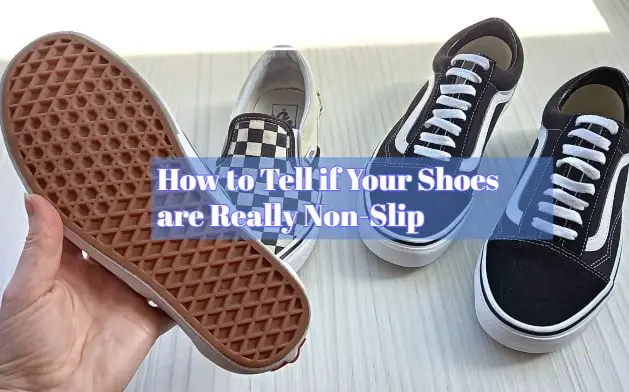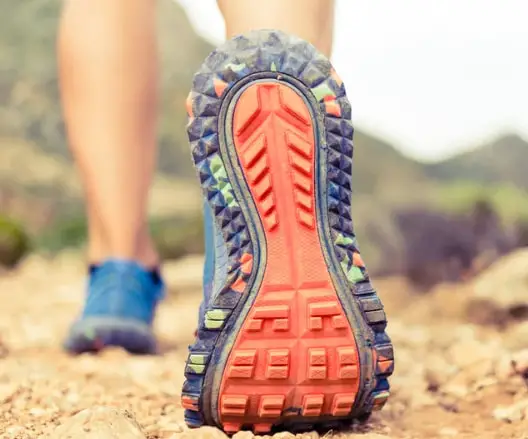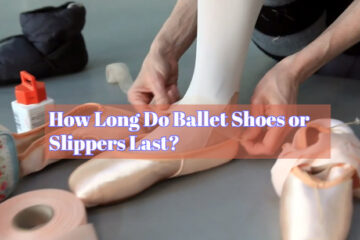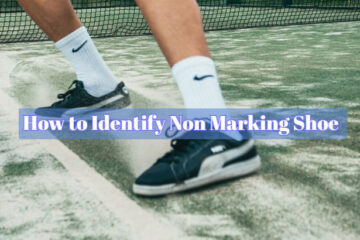Slipping and falling can happen anywhere – from wet kitchen floors to slick bathroom tiles. But when your job requires standing for hours on end or working in potentially dangerous conditions, wearing non slip shoes can be a necessity. Question is – how can you be sure the shoes you buy actually live up to their non slip claims?
As someone who has worked as a server, cook, and now safety manager at an industrial plant, I’ve gone through my fair share of shoes over the years. Some claimed to have amazing traction, only to prove dangerously slick when it mattered most.
After learning the hard way too many times, I now know what to look for to ensure my footwear provides maximum slip resistance and keeps me on my feet. Read on for my tips and tricks to test for yourself if shoes are the real deal or just masquerading as safety footwear.

9 Ways to Tell if Shoes Are Non Slip
Don’t let inadequate footwear leave you flat on your back! Follow this guide to find slip-resistant shoes that cling like glue, even on slick surfaces. With the right knowledge, you can step lively over spilled drinks and puddles with confidence.
1. Don’t Slip Up – Look at the Shoe Outsole

The bottom of a shoe tells all. Flip your kicks over and inspect the outsole – this exterior layer hugs the ground and keeps you stable. Non slip shoe soles should be made of grippy rubber or lugged patterns to prevent sliding. Opt for heavy tread rather than smooth, flat bottoms.
Deep flex grooves, textured treads, and indents provide surface area for traction. Shoes with defined lugs, circles, or hexagons grip better on slippery floors. Outsoles may also say “oil resistant” or feature safety certification symbols.
While examining the bottom, check if the sole wraps up over the toe. This safeguards against liquids spilling over the shoe’s front. A bevelled heel also improves stability on slick terrain.
Don’t get caught flat-footed – scoping out the sole offers clues to a shoe’s slip resistance.
2. Peruse Product Descriptions For Safety Specs
Brands want to highlight safety features, so product descriptions often specify slip resistance. Keywords like “traction,” “grip,” “non slip,” and “slip resistant” indicate shoes designed for stability.
Look for exact specifications like the coefficient of friction (COF). This measures how much friction force a shoe exerts to counteract sliding. Higher coefficients equal better traction – non slip shoes usually start at 0.5 COF.
You might also see references to industry standards like ASTM International safety certification. More on that later! For now, read product descriptions carefully to learn if shoes deliver slip-free strides.
3. Focus Your Attention on the Heel
While the whole outsole needs traction, the heel bears most of the burden when it comes to slip prevention.
- A defined heel (also called a heel brake) helps stop momentum when walking and prevents slips. It should protrude by at least 1/8 inch.
- The best heel for traction is wide and has lateral grooves/lugs to catch when pivoting or changing direction.
- A flared heel shape improves braking power and stability compared to low-profile designs.
- Rock the shoe to test if the heel is rigid enough to prevent rollover. Excessive inward collapsing can lead to ankle rolls.
Scrutinize the heel shape, material, lugs and rigidity. An inferior design spells instability and accidents waiting to happen.
4. Certification Seals Confirm Slip Resistance
Scanning for certification seals streamlines the search for legit non slip shoes. Respected organizations assess footwear traction and award badges verifying effectiveness. These seals take the guesswork out of choosing safe, slip-free shoes.
In the US, look for the green “SR”(slip resistant) tag from the American Society for Testing and Materials (ASTM). The Occupational Safety and Health Administration (OSHA) also recognizes ASTM standards.
Meanwhile, the blue SRC (Slip Resistance Check) tag signals certification under European safety standards from the International Organization for Standardization (ISO).
Shoes displaying these seals passed rigorous slip tests. The marks verify protection from falls and confidence underfoot. Certification symbols take the stress out of finding non slip shoes that make the grade.
5. Test Drive Potential Shoes Across Sample Surfaces

To truly gauge slip resistance, you’ve gotta get traction in action. Whenever possible, test shoes on the types of floors you’ll encounter. Many stores have vinyl tiles you can assess grip on.
Simulate spills by misting sample surfaces like ceramic, concrete, wood, or metal. Shuffle, pivot, and lean on each surface – non slip shoes should keep you steady and supported. Pay attention to how the sole grips during movement.
Bring samples from home too – kitchen grease, bath oil, garage lubricants. Smear them on floor tiles and step in them while wearing shoes. You want footwear that sticks through slick substances without sliding.
By trying shoes across mock conditions, you can verify which provide a sure footing when and where you need it. Don’t just take the company’s word for it – put their claims to the test!
6. Quality Craftsmanship Means Durable Non Slip Shoes
Well-constructed shoes withstand wear and tear while maintaining traction. Signs of quality include:
- Firm, non-flexible soles – Bendy soles compress underfoot, reducing surface area touching the ground. Rigid construction keeps the greatest sole surface in contact with the floor.
- Reinforced stitching – Tight, durable stitching prevents sole separation after prolonged use. Watch for double stitching along the perimeter.
- Supportive heel counters – The rear part wrapped around the heel should feel solid. counters prevent rolling or loose heels.
- Shock-absorbing midsoles – Cushiony foam or inserts prevent foot strain while providing structure underfoot.
While assessing slip resistance, ensure shoes are well-made overall. Premium materials withstand exposure to spills and accidents over time. Don’t slip into flimsy footwear – quality preserves safety and traction.
7. Grill the Seller For Inside Intel
Don’t be shy – ask store associates targeted questions to drill down on slip resistance. Retail workers are familiar with shoe traction features. Explain your environment’s hazards and ask which designs offer the best grip.
Query specifics like:
- What outsole compounds prevent sliding?
- Do any models have safety certifications?
- Which shoes are most popular with restaurant servers and healthcare workers?
- Have customers reported good results in wet/oily conditions?
- Are there design aspects that improve stability?
A worker well-versed in a shoe’s traction capabilities can point you towards appropriate options. They may even reveal insider tips or user reviews that distinguish truly non slip shoes.
8. Try On Different Shoes and Stomp Around
You gotta feel footwear yourself and get used to any balance differences. Certain styles may grip well yet feel awkward or uncomfortable. Try shoes on both feet and wear them around the store.
Simulate slippery situations by scuffing and twisting. Putting shoes through their paces reveals stability pros and cons. Test various brands and models since traction, fit, and feel vary.
Changing directions and surfaces during a test walk also assesses grip. Try walking on carpet then pivoting onto tile or metal grates. Stomp, shuffle, and slide to mimic slippery scenarios.
And don’t forget to account for job-specific gear like anti-slip socks, insoles, or orthotics. Try shoes with these additions to check for compatibility. Test drives catch traction issues before you take a tumble.
9. Consult User Reviews For Candid Insight
Fellow shoppers provide transparency regarding how shoes really hold up. User reviews cut through the marketing hype with candid reactions. Look for feedback referencing slip-resistant traits like:
- Traction and grip on wet, greasy, or slick floors
- Stability while moving quickly and frequently changing direction
- Performance in workplace contexts like restaurant kitchens and hospitals
- Durability and maintenance of slip resistance over time
- Comfort, fit, and support for standing all day
For balanced perspectives, read both positive and critical reviews. Numerous ratings mentioning good slip resistance indicate safe shoes. But repeated complaints about sliding or falls signal issues. Check reviews across multiple sites for a complete picture.
By tapping into user experiences, you gain deeper insight on real-world non slip performance. Customer verdicts help pinpoint ideal shoes for sure footing amidst slippery situations. Their tales of traction help you avoid preventable tumbles.
Conclusion
Choosing slip-resistant shoes requires checking key indicators like specialized soles, certification badges, user reviews, and first-hand testing. Focus on safety certifications, visible traction lugs, quality build, and verified grip when making decisions. With the knowledge from this guide, you can identify ideal non slip shoes tailored to your unique workplace hazards and comfort needs. Protect yourself from preventable slips and falls by making an informed choice using these tips. Safety and confidence await your steps in the right non slip footwear.
8 FAQs About Choosing Non Slip Shoes:
1. What features make shoes non slip?
Key traits of non slip shoes include textured rubber soles, deep flex grooves/lugs for traction, certification seals like SRC/ASTM, beveled heels for stability, and designed slip resistance mentioned in descriptions.
2. How do you test non slip shoes?
Test by purposefully walking on wet or greased floor samples, changing directions sharply, scuffing feet and leaning forward. Shoes should grip in all motions without sliding. Trying with workplace liquids helps too.
3. Do non slip shoes last?
Quality non slip shoes withstand exposure to spills/falls and maintain traction over time. Signs of durable shoes include rigid soles, reinforced stitching, strong heel counters, and shock-absorbing midsoles.
4. What jobs require non slip shoes?
Restaurant servers, kitchen staff, healthcare workers, maintenance crews, factory workers, and hospitality staff often wear non slip shoes for safety. Other slippery workplaces benefit too.
5. Are non slip shoes comfortable?
Comfort varies by brand and style. Trying on different pairs helps choose what feels best for all-day wear. Adding supportive insoles/socks improves comfort too. Prioritize fit and cushioning alongside slip resistance.
6. Can any shoes be non slip?
Not necessarily. While add-ons like grips and tape create more traction, only shoes designed and tested for non slip performance deliver reliable stability. Purpose-built traction is best for safety.
7. Do Crocs make good non slip shoes?
Some Crocs models like the Bistro Clog feature enhanced tread and achieved SRC certification, making them viable non slip options. Individual comfort with Crocs’ design impacts results.
8. Are non slip shoes attractive?
Appearance varies greatly across non slip shoes. Many leading brands now offer more stylish designs alongside traditional clogs. There are attractive options for most workplaces requiring slip safety.



